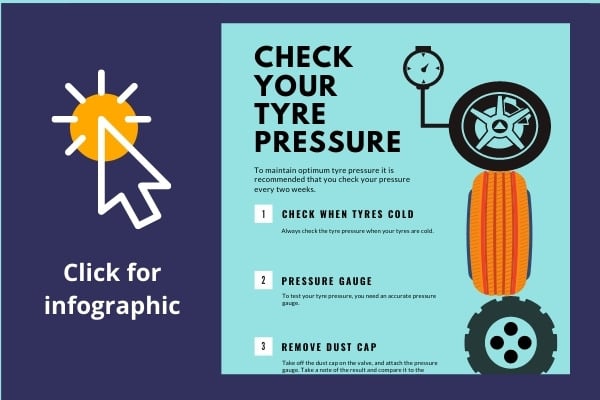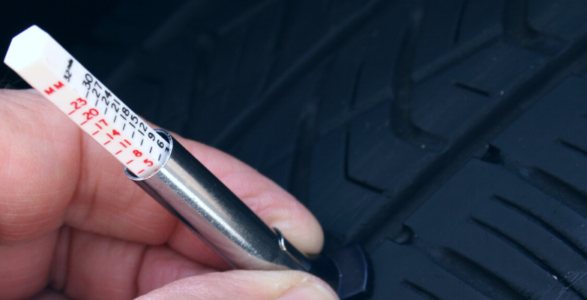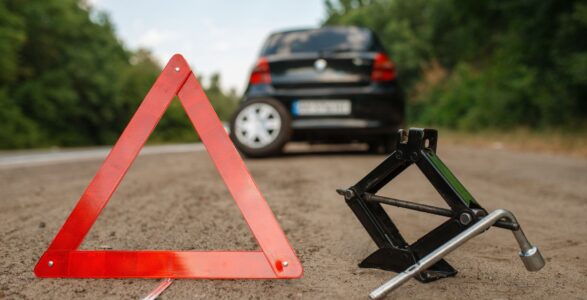How to Check Your Tyre Pressure

Last Updated 8 July 2022 | Published 24 October 2019
According to RAC research 2 million drivers never check their tyre pressure between visits to a garage.
Why you need to check your tyre pressure often
Correct tyre pressure is vital to your safety on the road, giving you optimum handling and grip. You will also keep your running costs down as incorrect tyre pressure causes your car to use more fuel.
Tyres leak air over time, this means that over a period of time they will deflate. Generally air escapes at the rate of up to two PSI of air every month. In warmer weather air escapes faster so more regular checks are required.
To maintain optimum tyre pressure it is recommended that you check your pressure every two weeks.
Benefits of correctly inflated tyres
Advantages of maintaining correct pressures include: increased safety through superior handling, shorter braking distances, reduced chance of aquaplaning, lower tyre wear, lower fuel requirements and reduced carbon dioxide emissions.
What happens if tyres are over inflated?
If you have over inflated tyres the area of the tyre that is in contact with the road is reduced. This can lead to loss of grip and longer braking distances. Overly inflated tyres also cause uneven wear across the central part of the tyre causing the tyre to need replacing more quickly.
What happens if tyres are under inflated?
Under inflated tyres have uneven contact with the road which impacts steering and also increases the time it takes to break. Tyres that are under inflated will wear excessively on the inside and outside edges. If you leave tyres under inflated you will need to visit the petrol station more frequently.
How is tyre pressure measured?
Car tyre pressure is measured by calculating the amount of air that has been pumped into the inner lining of your tyre in one of two ways:
- Pounds per square inch (PSI)
- Bar which is equivalent to 14.5038 PSI.
What is the correct tyre pressure?
Every vehicle manufacturer will specify the suitable tyre pressure, and may even suggest different tyre pressures for your front and rear tyres so check carefully. To find the tyre pressure for your vehicle look in one of three places:
1. Inside the drivers door on the ledge
2. Inside the petrol / diesel cap
3. In the vehicle manual
When you locate the pressure chart for your vehicle, you will find that pressure varies depending on the weight of your load. e.g . when you’re travelling alone, the pressure should be different from when your vehicle is loaded with family, baggage etc.
The right way to check your tyre pressure
- Always check the tyre pressure when your tyres are cold.
- To test your tyre pressure, you need an accurate pressure gauge.
- Take off the dust cap on the valve, and attach the pressure gauge. Take a note of the result and compare it to the manufacturer’s recommended tyre pressure.
- If your tyre needs extra air, you should inflate it using an air pump at home, or use the facilities provided in many petrol stations.
- If the tyre is overinflated according to the pressure chart, you can allow air to escape whilst the dust cap is off.
- When your tyres are at the right pressure re connect the dust cap.
Summary
- Carry out a tyre pressure check every two weeks.
- Tyres must be cold when you carry out the check.
- Get the right pressure reading from your vehicle manual, driver’s door ledge, or fuel cap
- Use a dependable gauge to measure your pressure.
- Don’t forget to check your spare tyre if you have one.
- During your pressure check, give your tyre a visual check for tread wear or problems like slashes/cuts/bulges.
- Check tyres more frequently in summer time.
Compass Vehicle Services Ltd offer: nationwide car leasing – bad credit car finance – used car deals – personal leasing – business car leasing – best car lease deals – non-status car leasing
Back to all help and advice articles







